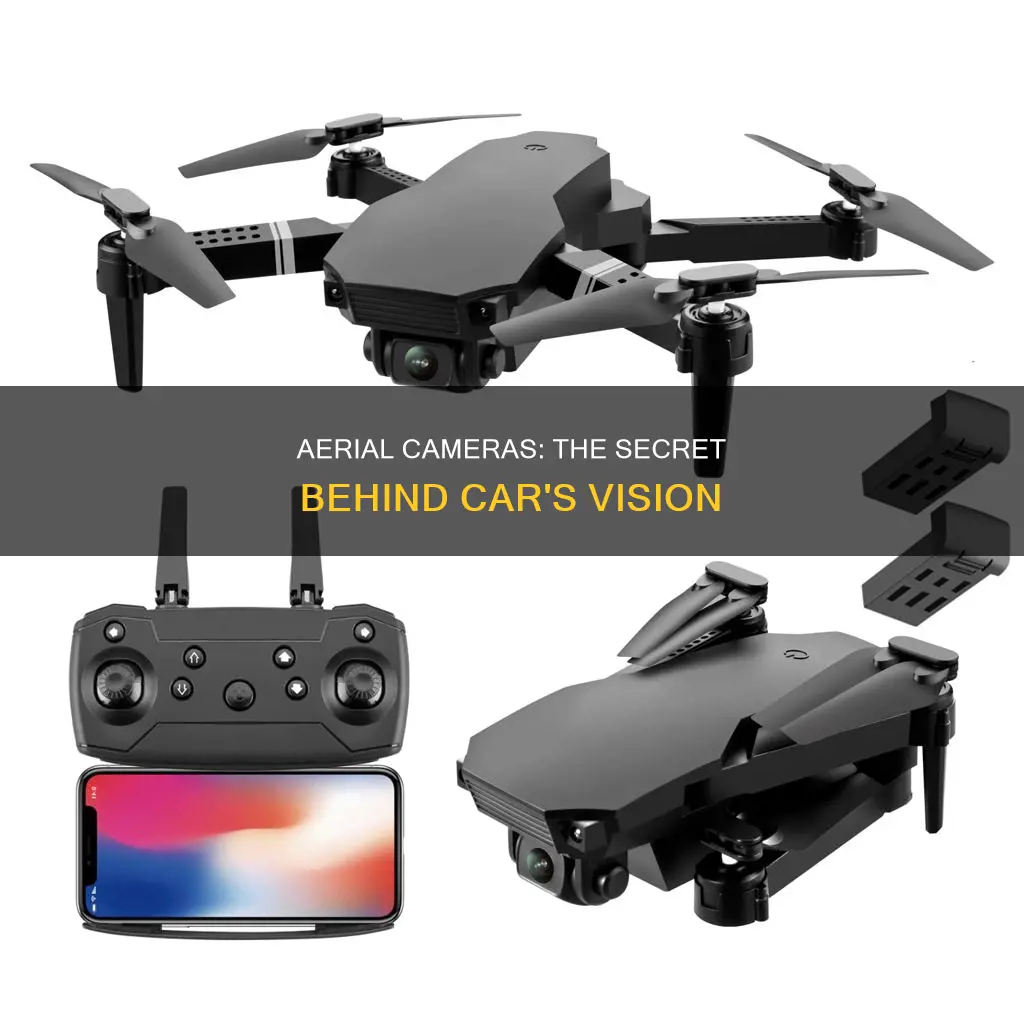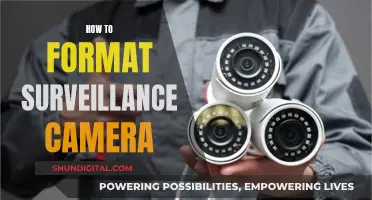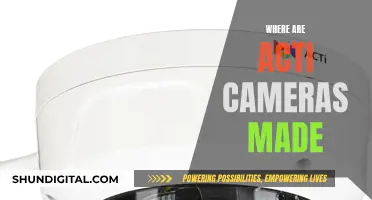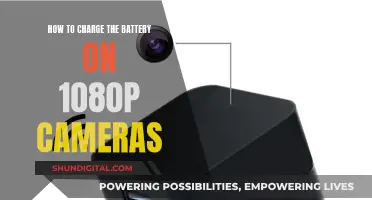
The 360-degree camera, also known as the bird's-eye view camera, is an advanced car feature that provides a top-down, holistic view of the vehicle and its surroundings. This technology, offered by many automakers, enhances safety and assists drivers in parking and manoeuvring. The system uses multiple cameras positioned around the vehicle, typically including the front grille, side mirrors, and rear, to capture wide-angle lens images. These images are then stitched together by image-processing software to create a seamless, simulated aerial view displayed on the infotainment screen. The result is a comprehensive understanding of the car's perimeter, aiding in navigating tight spaces and avoiding obstacles.
| Characteristics | Values |
|---|---|
| Number of Cameras | 4-6 |
| Camera Placement | Front grille, under the side mirrors, near the boot latch, ahead of the front wheels |
| Camera Lenses | Wide-angle |
| Display | Touchscreen, infotainment system |
| Display View | Top-down, split-screen, forward, rear, side |
| Camera Activation | Reverse gear |
| Additional Features | Proximity sensors, audio alerts, guidelines, dotted lines, parking sensors |
What You'll Learn

Camera placement
Typically, four to six cameras with wide-angle lenses are integrated into the body panels of the vehicle. Here are the common placement locations for these cameras:
- Front grille: One camera is usually placed in the middle of the front grille to capture the forward view.
- Side-view mirrors: Two ultra-wide-angle cameras are positioned in the exterior side-view mirror areas, providing a view of the flanks of the car.
- Rear: A camera is placed at the back of the vehicle, often above the license plate, serving as the rear-view or backup camera.
- Front wheels: Some systems may include side-view cameras positioned near the front wheels, allowing drivers to see what's on the other side of obstacles.
To ensure optimal performance, camera calibration is essential. Even slight differences in camera placement can affect the output, so intrinsic and extrinsic calibration is crucial for the surround-view camera system to function accurately.
Exploring the Creative Power of Camera Raw's Effects Tab
You may want to see also

Camera calibration
The first step in calibrating a car's aerial camera is to understand the camera's specifications and capabilities. This includes knowing the camera's resolution, frame rate, lens type, and field of view. This information is crucial for setting up the camera correctly and ensuring it captures the necessary data.
The positioning of the camera is vital for accurate data collection. The camera should be mounted securely and positioned to capture a clear, unobstructed view of the surrounding area. The height and angle of the camera need to be adjusted to ensure it captures a bird's-eye view, providing a comprehensive overview of the car and its surroundings.
The camera's focus and exposure settings need to be calibrated to ensure optimal image quality. Proper focus ensures that objects are sharp and clearly visible, while appropriate exposure settings ensure that the images are neither too bright nor too dark, affecting the visibility of important details.
Distortion correction is another essential aspect of camera calibration. All lenses introduce some level of distortion, which can affect the accuracy of the captured images. Calibration techniques, such as using a calibration pattern or specialised software, can help measure and correct for lens distortion, ensuring that the images accurately represent the scene.
Aligning the camera with the vehicle's coordinate system is crucial for accurate data interpretation. This involves defining the camera's position and orientation relative to the car's axes, ensuring that the data collected by the camera can be accurately mapped and interpreted in relation to the vehicle's movement and position.
Finally, testing and validation are necessary to ensure that the camera system functions as expected. This includes testing the camera's performance in different lighting conditions, weather scenarios, and driving situations to ensure that it consistently provides clear and accurate data, allowing the driver to make informed decisions.
Accessing Your Camera on Windows 7: A Step-by-Step Guide
You may want to see also

Image stitching
Many modern cars are now equipped with a 360-degree camera, also known as a "bird's-eye view" or "surround view" camera. This technology provides a composite of camera angles from several locations around the vehicle, resulting in an overhead perspective of the vehicle and its surroundings. The image displayed on the vehicle's screen is similar to what a drone or blimp would capture. This feature is incredibly useful when backing into or out of confined spaces, such as when parallel parking.
The 360-degree camera system typically uses at least four cameras positioned at the rearview, side-view, and front of the vehicle. These cameras capture multiple images with overlapping sections, which are then stitched together using image-processing software to create a single, seamless, panoramic image. This process is known as image stitching.
The process of image stitching can be complex and time-consuming, requiring fine-tuning and advanced image-processing algorithms. One technique used in image stitching is the Scale-Invariant Feature Transformation (SIFT) algorithm, which detects features in images and combines them using a Homography matrix. This allows for the accurate transformation and alignment of multiple images.
By utilising image stitching, car manufacturers can provide drivers with a valuable tool that enhances safety and situational awareness. The bird's-eye view offered by these camera systems can assist in various driving scenarios, from parallel parking in tight spaces to navigating off-road obstacles.
How to Identify Your Computer's Camera Model
You may want to see also

Proximity sensors
One of the primary functions of proximity sensors in cars is to assist with parking. These sensors can detect available parking spaces and alert drivers when they are close to an obstacle, such as another vehicle or a wall. They are also useful for unlocking car doors when the owner is nearby, and some sensors can even detect and prevent car injuries by quickly reversing the powered closure element.
There are several types of proximity sensors available for cars, each with its own unique characteristics:
- Inductive proximity sensors: These sensors use an electromagnetic field to detect nearby metal objects. This field is generated by coils of wire, and the sensor detects changes in the field to identify objects.
- Capacitive proximity sensors: Capacitive sensors use an electric field to sense the presence of objects. They consist of two parallel plates with a dielectric material between them. When connected to a battery, the plates become oppositely charged, and the sensor can detect objects by changes in capacitance.
- Radar capacitive proximity sensors: This type of sensor has a longer detection range than typical proximity sensors. They can detect objects several feet away and are commonly used in keyless entry systems.
- Ultrasonic proximity sensors: Ultrasonic sensors use transducers to send and receive ultrasonic pulses, which bounce off objects and provide information about their distance.
- Micro proximity sensors: Micro sensors have a concise range and are used to detect objects very close to the car, helping to prevent collisions.
- Laser proximity sensors: Laser sensors emit a laser beam and detect objects through beam reflection. They are ideal for small to medium-sized objects and can measure distances of up to 10 feet.
When choosing a proximity sensor system for a car, it is essential to consider the range, type of sensor, object detection capabilities, and ease of installation. Some sensors are designed to be discreet and hardly visible from the exterior of the vehicle. Additionally, some systems may require professional installation, especially those that involve drilling or wiring.
In conclusion, proximity sensors play a crucial role in enhancing the safety and functionality of modern automobiles. By incorporating these sensors into their vehicles, drivers can benefit from improved awareness of their surroundings, easier parking, and better overall driving experiences.
Understanding Camera's Depth Mode: How It Works
You may want to see also

Displaying the image
The image captured by the aerial camera in cars is displayed on a screen, usually a touchscreen, in the vehicle. This screen is often the infotainment display. The image is projected onto this screen in real-time, providing a live feed from the camera.
The image displayed is a composite of camera angles from several cameras positioned around the vehicle. The number of cameras varies, but typically there are four cameras in total. These cameras are strategically placed to capture different views and angles, which are then combined to form a single, coherent, seamless image.
The rearview camera is standard in all new cars and provides a view of the area immediately behind the vehicle. Additionally, side-view cameras are typically mounted on the outboard side mirrors, and a front-facing camera is usually positioned in the grille or front fascia. For a 360-degree view, a sixth camera may be added, enhancing the driver's visibility of their surroundings.
The images from these cameras are fed into an image-processing program, which stitches them together to create a top-down, bird's-eye view of the car and its surroundings. This synthesised image is positionally accurate and highly detailed, providing a clear and realistic depiction of the area around the vehicle.
The display screen shows a representation of the car in the centre of the image, with surrounding objects and obstacles visible. This includes curbs, fences, boulders, other vehicles, and any nearby objects that may be relevant to the driver, such as a tricycle. The system may also superimpose guidelines onto the image, indicating the vehicle's orientation and expected direction of travel based on gear selection and steering-wheel angle.
The bird's-eye view camera system offers multiple viewing options to assist drivers in various situations. For instance, drivers can select different camera angles to view the passenger side of the vehicle, areas below the front field of vision, or directly behind the car. This provides valuable visibility when navigating complex or confined spaces, such as pulling out of a blind alley or parallel parking.
Eco Mode: Camera's Power-Saving Feature
You may want to see also
Frequently asked questions
An aerial camera in a car is called a bird's-eye view camera, a 360-degree camera, or a surround-view camera.
A bird's-eye view camera uses multiple cameras placed around the car to capture images of the surroundings. These images are then stitched together using image-processing software to create a composite image that appears as if it were captured by a drone flying above the car.
A bird's-eye view camera can be extremely helpful when parking, especially in tight or narrow spaces. It allows drivers to see obstacles around the car that may be difficult to spot from the driver's seat, reducing the risk of bumps and scrapes.
Many car manufacturers offer bird's-eye view cameras as an option, including Toyota, Nissan, Chevrolet, Infiniti, Hyundai, Lincoln, Genesis, and Mitsubishi.
The cost of a bird's-eye view camera can vary depending on the car brand and model. In most cases, it is offered as an add-on feature for higher trim levels or as part of an option package, which can cost several thousand dollars. For aftermarket installations, the cost of the camera kit can range from $200 to $1,200, plus installation charges.







